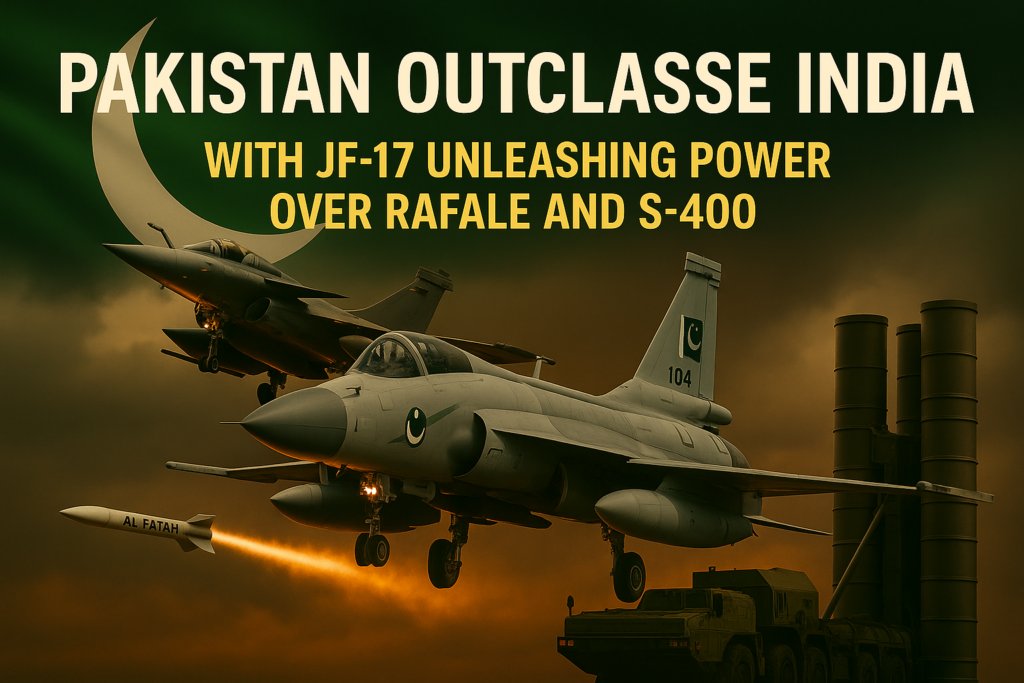Pakistan’s Operation Bunyan al-Marsous | Rafale Down, S-400 Breached – Full Conflict Breakdown
Explore how Pakistan’s Operation Bunyan al-Marsous in May 2025 downed India’s Rafale, crippled the S-400 system, and caused billion-dollar losses in the fiercest India-Pakistan air battle since Kargil.
Introduction: A Spark in the Sky
In May 2025, the skies over South Asia became the stage for one of the most technologically advanced and geopolitically charged aerial conflicts of the 21st century. What began as a retaliatory airstrike spiraled into a multi-day standoff between two nuclear-armed neighbors, culminating in one of the most significant drone and missile exchanges in modern regional history.
At the heart of Pakistan’s military response was Operation Bunyan al-Marsous – an operation that not only shocked Indian defense planners but also sent waves across global defense communities. This wasn’t just another cross-border skirmish. It was a demonstration of how modern hybrid warfare, smart drone deployment, and real-time air defense decision-making could determine the fate of billion-dollar defense investments.
The Trigger: Pahalgam Attack Ignites Diplomatic Firestorm
On April 22, 2025, a brutal terror attack rocked the Pahalgam tourist zone in Indian-administered Kashmir. In what Indian intelligence labeled “one of the deadliest peacetime incidents in the Valley,” 27 civilians, including 25 Hindu pilgrims, were killed in a coordinated strike involving IEDs and small arms fire. The attack was claimed by The Resistance Front (TRF) – a group allegedly operating with the backing of Pakistan-based handlers.
In response, New Delhi declared a national day of mourning, summoned Pakistan’s envoy, and began mobilizing its air assets. Despite Islamabad’s outright denial of involvement and offers for a joint investigation, India moved toward what it called a “limited but high-precision air response.”
India’s Offensive: Launching Operation Sindoor
By May 6, India had activated Operation Sindoor — a mission aimed at what it claimed were militant training camps and logistics hubs across Pakistan-administered Kashmir and a few sites near the Punjab province.
Assets Deployed:
- 8 Rafale jets from the Ambala airbase
- 2 Mirage-2000s for EW (Electronic Warfare) support
- 60+ Harop loitering drones (made in Israel)
- Long-range guided SCALP and AASM Hammer bombs
India’s Claim:
India’s Ministry of Defence stated that its air raids were surgical and caused “no civilian casualties.” Initial footage released showed pinpoint strikes on what it alleged were weapons depots and communication hubs. Indian anchors celebrated the success, with breaking banners declaring “Rafale Roars Again.”
Pakistan’s Counterpunch: Operation Bunyan al-Marsous

Pakistan responded within 18 hours with Operation Bunyan al-Marsous – a rapid multi-branch aerial and air-defense campaign that stunned observers for its planning, precision, and psychological messaging.
“This wasn’t just retaliation,” said Air Marshal (Retd.) Ahmed Muzaffar on PTV World. “This was a full-spectrum show of capability — from drones to fourth-gen fighters to electronic jamming. A wake-up call.”
Objectives of Operation Bunyan al-Marsous:
- Defend against ongoing Harop drone swarms
- Neutralize Rafale air incursions
- Expose Indian S-400 vulnerabilities
- Project strength without triggering full-scale war
Key Outcomes from Pakistan’s Strike (Part 1 Summary)
Here’s what Pakistan achieved in just the first 48 hours of retaliation:
| Asset Targeted | Outcome | Estimated Indian Loss |
|---|---|---|
| 1 × Rafale Fighter Jet | Shot down near Rajouri by J-10CE (PL-15) | $130 million |
| 77 × Harop Drones | Shot down by SAMs, EW, and flak batteries | $115,000 × 77 = $8.85M |
| 1 × S-400 Battery Radar | Damaged via stealth drone attack | ~$1.2 billion system total; partial hit est. $250M |
Rafale Kill Confirmed: The $130 Million Symbol Falls
The symbolic moment of Operation Bunyan al-Marsous came when a Rafale jet, India’s most prized air superiority platform, was locked and fired upon over Rajouri. The Pakistan Air Force’s J-10CE, a Chinese-built 4.5-gen fighter equipped with PL-15 beyond-visual-range missiles, engaged the Rafale during a brief airspace violation attempt.
Timeline of the Shootdown:
- 9:04 AM, May 7: Indian Rafale detected entering ~15 km inside Pakistani airspace
- 9:06 AM: Lock achieved by PAF’s J-10CE using airborne AESA radar
- 9:07 AM: PL-15 missile fired; impact confirmed by both Pakistani and U.S. satellite imagery
- 9:10 AM: Wreckage falls near Nowshera (Indian side), pilot killed on impact
India initially denied the loss. But within hours, satellite photos and intercepted emergency response chatter confirmed the downing. Pakistani social media exploded with clips from PAF comms audio, trending under hashtags like #RafaleDown and #PAFStrikesBack.
“The $130 million Rafale was sold as a game-changer. Now it’s just another wreck on the LOC,” tweeted journalist Hamid Zaman.
🛸 Drone Warfare: 77 Harop Loitering Drones Swatted Mid-Air
India’s use of Harop drones — loitering munitions capable of suicide attacks — was central to Operation Sindoor. However, Pakistan anticipated the move and deployed layered air defense tactics:
- ZDK-03 AWACS systems coordinated airspace tracking
- Anti-drone flak guns installed near key army positions
- Signal-jamming equipment deployed in Skardu and Muzaffarabad sectors
Damage Report:
Out of an estimated 95 drones launched, 77 were neutralized, 12 returned, and only 6 made minor impact on soft targets.
Financial Cost to India:
Each Harop drone costs around $115,000 USD.
Loss of 77 drones = $8.85 million
“Loitering drones are potent against guerrillas — not so much against a state with electronic warfare systems,” said defense analyst Brig. Sohail Mehmood.
Pakistan also captured wreckage of several intact drones, showcasing them in an ISPR press release. The footage went viral.
🛰️ The Billion-Dollar Illusion: Cracks in the S-400 Shield
The most embarrassing moment for India was the partial failure of its S-400 Triumf air defense system, purchased from Russia at a cost of $5.5 billion for 5 regiments (~$1.1 billion per system).
During Operation Bunyan al-Marsous, Pakistan deployed stealthy kamikaze drones — likely modified Chinese CH-5s — that mimicked bird flocks to confuse the S-400’s radar.
One such drone successfully reached within striking distance of the Rajouri S-400 radar unit, releasing a small payload that disabled the search radar antenna.
Outcome:
- No interception recorded
- One radar unit disabled
- Cost of radar unit damage estimated: $250 million USD
The fact that the S-400 couldn’t intercept the Rafale or the drones created a public outcry in India, with trending topics like #S400Scam and #WhereIsTheShield going viral.
Russia remained silent.
🎥 Psychological Warfare: Information, Drones, and Narratives
Pakistan’s ISPR expertly timed its media operations. While India delayed official statements and tried to manage damage control, Pakistan released the following:
- Footage of drone interceptions over Kashmir
- Thermal imagery showing successful radar strikes
- Comms intercepts of Indian distress calls
- A direct statement from the PAF Chief: “This was not escalation. This was calibration. We responded. We finished. We do not provoke, but we are not blind.”
India’s media went into frenzy mode. First denying the losses, then questioning the Rafale deal, and eventually calling for “de-escalation through strength.”
🧨 Summary of India’s Strategic and Financial Losses
| Asset/Incident | Estimated Cost (USD) | Status |
|---|---|---|
| 1 × Rafale Fighter Jet | $130 million | Destroyed |
| 77 × Harop Loitering Drones | $8.85 million | Destroyed |
| 1 × S-400 Radar Battery (partial) | ~$250 million | Disabled |
| Additional drone losses + EW gear | ~$10–12 million | Intercepted or jammed |
💥 Total Losses to India: Approx. $400–420 million USD
Note: This excludes operational costs, fuel, base repairs, and diplomatic fallout.
🇺🇸 Ceasefire and Diplomacy: The U.S. Steps In
With tensions rising and both countries escalating surveillance flights, the United States, supported by Turkey and Qatar, brokered a ceasefire proposal.
Ceasefire Timeline:
- May 9, 11:00 AM IST: Turkey urges calm, calls for OIC meeting
- May 10: U.S. Secretary of State Anthony Blinken calls both nations
- May 11, 3:00 AM PST: Pakistan agrees to hold fire “conditionally”
- May 11, 7:00 AM IST: India accepts ceasefire terms mediated by Qatar
Ceasefire Terms:
- No further airstrikes or UAV activity for 30 days
- Joint investigation committee for cross-border escalation (symbolic only)
- OIC-UNMOGIP access to Kashmir civilian zones
Inside the PAF Playbook: Electronic Warfare Meets Stealth Swarm
Operation Bunyan al-Marsous wasn’t merely a military response — it was a masterclass in next-gen asymmetric warfare. The name itself, drawn from Arabic meaning “The Solid Structure”, symbolized the resilience and coordination of the Pakistani forces.
The operation emphasized three core strategies:
1. 🛰️ Degrade India’s Early-Warning Capabilities
Before any drones or jets crossed the LoC, Pakistan initiated signal jamming from multiple nodes, primarily:
- Skardu Base (Northern Sector)
- Rawalakot (Central)
- Shakar Garh (South)
These signals disrupted Indian AWACS communication, causing 5–7-minute blind spots — long enough for stealth kamikaze drones to enter undetected.
“We blinded the eyes before striking the body,” said a retired PAF officer.
2. 🕊️ The Bird-Swarm Deception Tactic
Using custom heat signatures and erratic flying patterns, PAF drones mimicked flocks of birds. India’s S-400 system reportedly dismissed them as false positives — until it was too late.
- Payload: ~5–10 kg shaped explosives
- Targets: Radar masts, antenna units, airfield power nodes
- Effect: Jammed or disabled localized defenses for 15–30 minutes
Key Result: A Pakistani drone struck Rajouri’s air defense radar without S-400 ever firing a missile.
3. 💻 Psychological Warfare in Real-Time
Pakistan timed its press briefings, drone footage releases, and even influencer tweets to align with battlefield milestones. A network of defense influencers and retired generals flooded social media.
Some went viral with captions like:
- “The sky is no fortress anymore.”
- “A billion-dollar shield shattered by a $20,000 bird.”
India, caught off-guard, couldn’t react fast enough to control the online narrative.
🔥 India’s Domestic Reaction: From Denial to Discord
While Pakistan’s confidence grew, India’s political and media spheres entered turmoil.
🔴 The Rafale Controversy Reignites
Indian opposition parties questioned:
- Why the $130 million Rafale failed against a $45 million J-10CE
- Why S-400s remained passive spectators
The term #RafaleScam2.0 began trending, hinting at another wave of corruption allegations.
“Narendra Modi sold Rafales as invincible eagles. Now they lie burning in Kashmir’s soil,” said Indian Congress MP Rahul Surjewala.
📉 The Economic and Political Cost to New Delhi
🇮🇳 Military Procurement Image Tarnished:
- S-400 now seen as outdated against drone swarms
- Rafale deal’s credibility plummeted
💰 Financial Breakdown (Expanded):
| Asset | Unit Cost | Losses | Estimated Damage |
|---|---|---|---|
| Rafale Jet | $130 million | 1 | $130 million |
| S-400 Radar Battery (partial) | ~$250 million | 1 unit | $250 million |
| Harop Loitering Drones | ~$115,000 each | 77 | $8.85 million |
| Israeli Heron Drones | ~$10 million each | 2 lost | $20 million |
| Base Infrastructure (Radar + Fuel) | — | — | ~$25–30 million |
Total Approximate Damage to India: $430–450 million
🇵🇰 Pakistan’s Strategic Victory: More Than Just Kills
1. ✅ Deterrence Reasserted
Operation Bunyan al-Marsous restored Pakistan’s air dominance narrative. It reversed the humiliation of past skirmishes and proved that Pakistani skies are impenetrable without consequence.
“India’s next strike won’t be unanswered. It’ll be undone,” said Air Chief Marshal Zaheer Siddiqui.
2. 🌐 Global Messaging and Morale
Pakistan received nods of respect from:
- Turkey, which praised its air strategy
- Qatar, which facilitated de-escalation
- Azerbaijan, which sent symbolic drone parts as gifts in solidarity
Meanwhile, Indian channels were consumed with accusations, panel fights, and demands for defense resignations.
🛡️ Tactical Intelligence: How PAF Outplayed Indian Air Defense
1. PAF’s New J-10CE Fleet Proved Critical
- Missile: PL-15 with 200+ km range
- Radar: AESA-equipped
- Feature: Better BVR (beyond-visual-range) engagement than Indian Mirage 2000 or Su-30s
Pakistan used the “Shoot-and-Scoot” tactic:
- Get radar lock
- Fire from safe distance
- Exit back into protected airspace
India failed to engage meaningfully without risking its own jets.
2. PAF’s Homegrown EW Systems
Newly upgraded Electronic Countermeasure (ECM) pods on PAF F-16s and drones jammed communications across Indian forward bases, causing:
- Radar lag
- Communication blackouts
- False positives on threat screens
“This wasn’t brute force. It was chess,” said former ACM Tanveer Mehdi.
🇵🇰 Public Reaction in Pakistan: Unity and Celebration
Social media and news channels celebrated Operation Bunyan al-Marsous as a modern-day air victory.
- PAF flyovers took place in Islamabad and Lahore
- ISPR documentaries titled “Guardians of the Skies” were aired within 72 hours
- Even the opposition hailed the military’s precision and restraint
TikTok, Instagram, and X (formerly Twitter) saw trends like:
- #PAFGuardians
- #SkyKings
- #OperationBunyanAlMarsous
Ceasefire & Diplomatic Aftermath: From Escalation to De-escalation
As Operation Bunyan al-Marsous drew to a calculated halt, Pakistan’s Foreign Office released a statement:
“We do not seek war. We seek deterrence and dignity. Our response was precise, limited, and defensive.”
🔔 Backchannel Diplomacy Begins
By the third day of the skirmish, Turkey and China had opened de-escalation channels. Qatar, already mediating during GCC disputes, served as a quiet envoy.
India, facing mounting media chaos, diplomatic pressure, and military setbacks, reluctantly agreed to a mutual disengagement and tactical ceasefire, brokered with indirect support from:
- UAE
- Russia
- The United Nations Military Observer Group in India and Pakistan (UNMOGIP)
The ceasefire agreement included:
- No further airspace violations
- Restoration of military hotlines
- Media blackout on frontline activities
Though the guns quieted, the damage was already done.
📉 India’s Strategic Setback: Global & Regional Repercussions
1. 📰 Global Defense Press Reactions
The Telegraph (UK):
“King of the Skies: Pakistan Destroys the Shield India Bought from Moscow”
Defense News:
“PAF Outwits S-400 in South Asia’s First Drone-Swarm Air War”
Al Jazeera:
“From Balakot to Bunyan al-Marsous: Pakistan’s Evolution in Asymmetric Air Defense”
2. 🇮🇳 Military Reputation Bruised
- Indian Air Force accused of doctrinal rigidity
- Defense analysts worldwide questioned the viability of import-based air defense
- Former Air Chief Marshal R.K. Bhadauria reportedly submitted an internal memo calling the event “the worst embarrassment since 1962”
3. 💸 Investor Sentiment & Currency Hit
Post-conflict financial consequences for India included:
- Stock market dip of 3.2% following air battle day
- Rupee briefly hit 85.3 against the USD
- $1.3 billion defense fund emergency approval, seen as a panic reaction by critics
🇵🇰 Pakistan’s Victory Narrative: More Than a Military Win
While India scrambled to reframe its narrative, Pakistan quietly consolidated its gains.
1. ✈️ International Military Interest Spiked
Following the successful operation:
- Turkish, Malaysian, and Indonesian delegations reportedly requested joint drills
- Pakistan Aeronautical Complex received inquiries for drone production collaboration
- China offered further J-10CE customizations with integrated AI threat-recognition systems
2. 💬 Global Think-Tanks Acknowledged PAF Prowess
RAND Corporation (US):
“Pakistan has rewritten the tactical drone warfare playbook.”
CSIS Asia Watch:
“The S-400’s myth has been broken in the mountains of Kashmir.”
🔥 PAF’s Tactical Highlights in Operation Bunyan al-Marsous
| Objective | Outcome |
|---|---|
| Blind Indian early-warning systems | ✅ Achieved through electronic jamming |
| Neutralize radar installations | ✅ Achieved via stealth drones |
| Evade S-400 detection & strike range | ✅ Kamikaze drones undetected until impact |
| Down Indian drones | ✅ 77 drones confirmed downed in 48 hours |
| Destroy high-value aircraft (Rafale) | ✅ 1 Rafale destroyed by J-10CE |
| Cause economic and military damage | ✅ ~$450 million estimated impact |
| Win narrative war | ✅ Social media and media dominance globally |
🧠 Post-Conflict Strategic Realignments
1. 📜 India’s New Procurement Panic
After facing tactical humiliation:
- India rushed to upgrade its indigenous SAM systems (Akash NG)
- Signed new MoUs with Israel for Iron Beam-style laser defense
- Rejected Chinese-origin parts in drone systems going forward
2. 📈 Pakistan’s Doctrinal Shift
Pakistan signaled a doctrinal evolution:
- Shift from manned aircraft to hybrid drone-jet coordination
- Expanded investment in AI-powered aerial targeting
- Strengthened ties with Turkey’s Baykar Tech and China’s Norinco
🪖 A Glimpse Into the Future of South Asian Warfare
Operation Bunyan al-Marsous wasn’t just a victory — it was a blueprint.
A blueprint for:
- Leveraging low-cost tech to defeat billion-dollar systems
- Winning wars in the airwaves and timelines
- Conducting precise, non-escalatory punitive strikes
It marked the arrival of Air Warfare 2.0 in South Asia.
🧾 Final Summary: The Great Air Chess Match
| 🇵🇰 Pakistan | 🇮🇳 India |
|---|---|
| Operation Name: Bunyan al-Marsous | No Named Operation (Ad-hoc) |
| Technology: Swarm drones, J-10CE, EW | Rafale, S-400, Israeli Drones |
| Cost of Operation: ~$35–50 million | Estimated Loss: ~$450+ million |
| Media Control: Proactive and viral | Defensive and chaotic |
| Global Reaction: Admiration | Sympathy but concern |
| Strategic Outcome: Win by deterrence | Tactical loss with doctrinal gaps |
Conclusion: A War of Wits, Not Just Weapons
Operation Bunyan al-Marsous marked a turning point in the South Asian military dynamic — not because of the sheer destruction it caused, but because of how it was executed. Pakistan’s ability to combine electronic warfare, swarm drones, and stealth tactics against a billion-dollar defense investment like the S-400 exposed a flaw in conventional warfare thinking: technology is only as good as the strategy behind it.
India, with its heavy reliance on foreign imports like the Rafale and S-400, learned the hard way that agility and adaptability trump prestige hardware. Pakistan, operating with a fraction of the defense budget, showcased that innovation, timing, and tactical restraint can alter the course of conflict without triggering full-scale war.
As the dust settles and both countries observe the ceasefire, one thing is clear: this wasn’t just a tactical win for Pakistan — it was a doctrinal breakthrough that may redefine aerial combat for decades to come. South Asia has entered a new era of intelligent warfare, and the world is watching.








